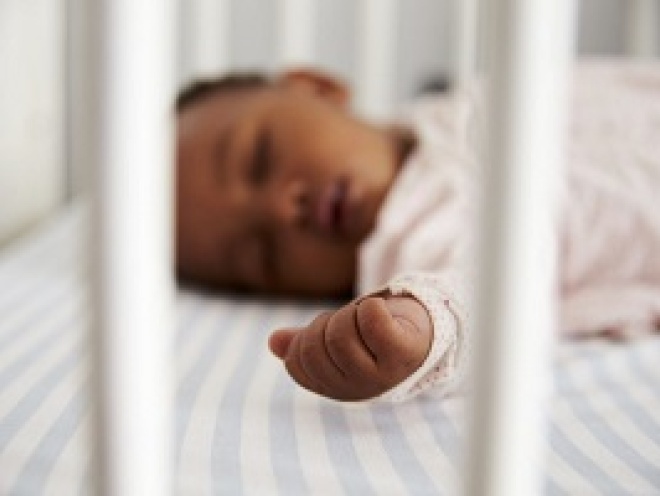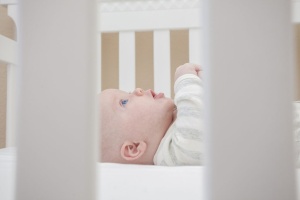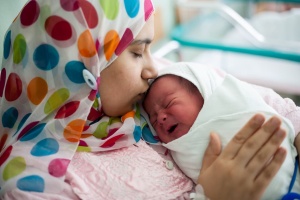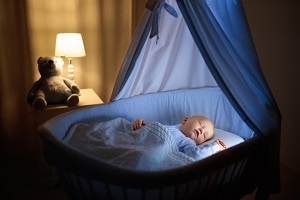With products changing and SIDs risks to account for, you might be feeling the pressure of getting your baby to sleep safely. Here’s a simple guide…
Your baby will spend more time sleeping during their first two years than they will awake. Although it might not feel like it when you’re yawning through a 3am feed. So getting things right with their sleeping environment is pretty crucial.
Watch our video to find out about safer sleep guidelines for babies.
What type of cot should I choose?
To keep your baby as safe as possible in their cot, check that it conforms to British Safety Standards BS EN 716:2008. You’ll also need to follow these guidelines so they don’t get trapped or climb out:
- The distance between the top of the mattress and the top of the cot sides should be at least 50cm.
- Cot bars should be vertical and the distance between them no less than 2.5cm and no more than 6.5cm (Which, 2021a).
- If your cot has a solid head and footboard with shapes cut out, check that your baby’s limbs can’t get caught in them.
(ROSPA, 2019))
Do I need two cots for my twins?
If you are short on space or cash the thought of two cots may be alarming. So long as you follow other safer sleep guidance you can decide to have your twins in separate sleeping areas from birth, or have them sleeping together (The Lullaby Trust, no date).
However, if sleeping together avoid a Moses basket or small cot as they could overheat (Lullaby Trust, no date).
Second hand cots: are they safe?
Yes – if you stick to a few checks and rules:
- Make sure the cot – even if old – conforms to current British or European safety standards. You will probably be able to find the manufacturers instructions online.
- If it’s vintage, it might need to be stripped down and repainted with paint that you’ve checked is ok to use on items like cots. Make sure it thoroughly dries. Cots made before 1973 could have been painted with leaded paint, which is toxic.
- If the cot has a drop-down side mechanism, it's important to make sure it works properly. You should be confident it's secure and won't drop accidentally. If in doubt, it's safer not to use the cot.
- Remove any stickers and transfers: they could be choking hazards.
- Check there is nothing sticking out of the top rail that may catch on your baby’s clothes.
- Check that there is nothing your baby could use as a foothold to climb out with.
(ROSPA, 2019)
Does it matter where I put the cot, crib or Moses basket?
The safest place for your baby to sleep for the first six months, day or night, is in a cot in the same room as you (NHS, 2021).
As your baby is less able to control their temperature than you are, don’t put them to sleep near a radiator or sunny window, for starters. Nearby blind cords should be secured safely away from your baby, and curtains and baby monitor cables need to be out of reach too (Lullaby Trust, no date).
Do I need to get a new mattress for my baby?
Ideally, you should buy a new mattress for any new baby (ROSPA, 2019).
However, the main reason for that is because of a possible small increased risk of SIDS in mattresses brought in from another home (Lullaby Trust, 2018).
Tests have also found that mattresses can lose their firmness after a few years and may not be suitable for a newborn (Which, 2021b).
So if the mattress has only been used by other children in your family, check that it:
- has not got any cracks or tears
- is firm, with no sagging
- fits the cot snugly with no gaps
- is clean and dry.
(Lullaby Trust, no date)
You should also give the waterproof layer a clean before you use it and put a fresh sheet on the mattress.
What mattress should I choose for my baby?
Whatever sort of mattress you choose, it should conform to safety standards BS 1877-10:1997 (Which, 2021b).
Mattresses come in either standard or continental size and go in their equivalent sized cot. Choose one that feels firm because your baby needs support while sleeping.
The mattress needs to be kept clean and dry so get one with a wipe-clean covering or a removable top panel that you can wash at a high temperature. Or use a mattress protector so that if (well, when…) your baby dribbles or their nappy leaks, the mattress won’t get wet (Which, 2021b; Lullaby Trust, no date).
Baby bedding: what should I use?
When it comes to baby bedding, think the opposite to your pillow and duvet-laden cosy king size. Instead, your baby’s cot should be as free from stuff as possible. Pillows and duvets are smothering risks for babies under one year old (Lullaby Trust, no date).
Go for a fitted sheet and a light blanket tucked in below your baby’s shoulder level. They should have their feet at the bottom of the cot or Moses basket so they don’t wriggle down (Lullaby Trust, no date).
If you're using a baby sleeping bag, it should fit well around the shoulders so that they can't wriggle down inside it.
Are cot bumpers really unsafe?
Cot bumpers are not considered safe because of the risk of accidents once your baby can roll and move in their cot. This is because some babies have become entangled in the ties and material (Lullaby Trust, no date). Your baby can also climb onto them (Scheers et al, 2015).
What’s the best way to protect my baby against SIDS?
- Put your baby to sleep on their back for all sleeps (see below).
- Your baby should sleep in the same room as you, day and night, for the first six months. This is where a portable crib or Moses basket can come in handy.
- Keep your baby smoke-free during pregnancy and after birth. According to The Lullaby Trust, Around 6 in 10 of sudden infant deaths could be avoided if no baby was exposed to smoke during pregnancy or around the home.
- Never sleep on a sofa or armchair with your baby, as a tired parent can smother the baby.
- A car seat is fine when they are in the car, but move them onto a firm, flat surface when you get home.
- Don't co-sleep with your baby if you or your partner has been drinking, is a smoker, has been taking drugs (including medication which makes them sleepy) or is extremely tired.
- Keep your baby’s cot clear of toys and loose bedding. All they need is a flat surface and simple bedding.
- Make sure your baby doesn't overheat. The ideal room temperature is between 16°C and 20°C. Use minimal layers and never use hot water bottles or similar products.
(Lullaby Trust, no date)
What position should my baby sleep in?
Babies should sleep on their back with their feet at the foot of the cot to stop them wriggling down under the covers (NHS, 2021).
Can my baby sleep with a pillow or duvet?
Again, less is more for sleeping babies. Babies should not have any duvets or pillows under the age of one (Lullaby Trust, no date).
This page was last reviewed in November 2021
Further information
Our support line offers practical and emotional support with feeding your baby and general enquiries for parents, members and volunteers: 0300 330 0700.
You might find attending one of our NCT New Baby groups helpful as they give you the opportunity to explore different approaches to important parenting issues with a qualified group leader and other new parents in your area.
Make friends with other parents-to-be and new parents in your local area for support and friendship by seeing what NCT activities are happening nearby.
The Lullaby Trust has lots of useful information and support for parents about safe sleep.
Lullaby Trust (no date). The best mattresses and bedding for your baby. Available from: https://www.lullabytrust.org.uk/safer-sleep-advice/mattresses-and-bedding/ [Accessed 12.11.2021]
NHS (2021) Reduce the risk of sudden infant death syndrome (SIDS). Available at: https://www.nhs.uk/conditions/baby/caring-for-a-newborn/reduce-the-risk-of-sudden-infant-death-syndrome/ [Accessed 12.11.2021]
ROSPA. (2019) Bedtime: a safe cot. Available from: https://www.rospa.com/Resources/Hubs/Keeping-Kids-Safe-(1)/Bedtime.aspx [Accessed 12.11.2021].
Scheers NJ, Woodard DW, Thach BT (2016). Crib Bumpers Continue to Cause Infant Deaths: A Need for a New Preventive Approach. J Pediatr. Available from: https://pubmed.ncbi.nlm.nih.gov/26621044/
Which (2021a) Using cot beds safely. Available at: https://www.which.co.uk/reviews/cot-beds/article/using-cot-beds-safely-adlri8j5kOBw [Accessed 12.11.2021]
Which (2021b) Cot mattress safety. Available at: https://www.which.co.uk/reviews/cot-mattresses/article/cot-mattress-safety-at19Y2M0qDEd [Accessed 12.11.2021]







